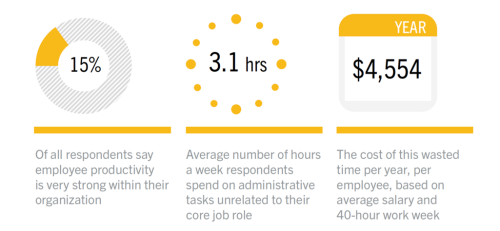
The Workforce Institute at Kronos has just published an eye-opening report on the cost of wasted time at work. The $687 Billion Question, discusses the impact of what Kronos labels engagement and what others might label productivity. The focus is on some surprising causes of low productivity in the workplace based on responses to research of conducted in 2016. It included 314 online surveys and detailed interviews with HR professionals (105), Operations/Line of Business managers (105) and employees (104) at companies with more than 600 employees in the Retail (21%), Healthcare (20%), Public Sector (20%), Manufacturing (19%), Service (16%), and Transportation and Logistics (4%) sectors.
The report shows in detail some unexpected — and wholly controllable — causes of low productivity and discusses the ramifications of just one hour of wasted time. And by wasted time, they don’t mean Snapchatting, staying current on Facebook, or making personal phone calls. They mean time wasted by inefficient processes and systems. Time wasted by dealing with office politics, with administrative tasks unrelated to the job, unnecessary complexity, and lack of appropriate skills – all contributing to low productivity at work.
The report provides data and analysis in five sections:
-
Stuck in the middle: People are torn between meeting customer needs and manager expectations
-
Small changes create big rewards: Why reducing one hour of wasted time can save billions of dollars
-
Why your greatest asset shouldn’t be a liability: Balancing the needs of people with the numbers
-
Bridging the engagement gap: Turning technology into an engagement tool and competitive advantage
-
Don’t dash for cash: Use communication, collaboration, and culture to keep employees engaged
Easily understood graphics abound and the discussion of the hard dollar losses to our organizations is compelling and important.
 That’s $4,554 per year per employee. That’s the $687 Billion price tag.
That’s $4,554 per year per employee. That’s the $687 Billion price tag.
So, if our employees spend additional time goofing off on social media, shopping online, or dealing with personal business while on the clock, the $687 billion cost just gets bigger and bigger. Not good. Definitely not good.
The $687B Question is a quick read and helps frame the cost of controllable kinds of unproductive employee time. This kind of lack or productivity is clearly able to be reduced. But first we have to be aware of it. What’s the cost in your organization?
*Note: I serve on the board of the Workforce Institute at Kronos






